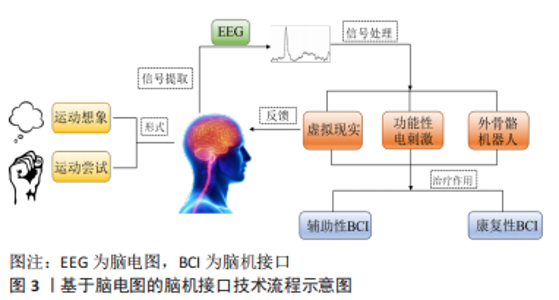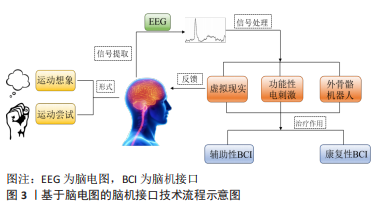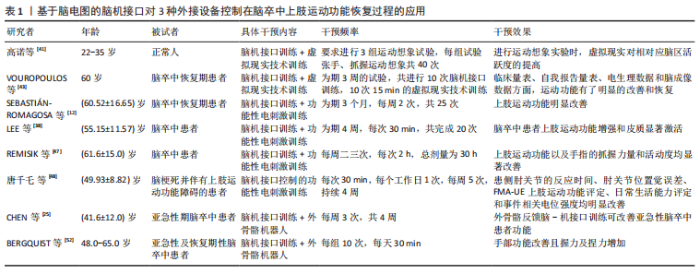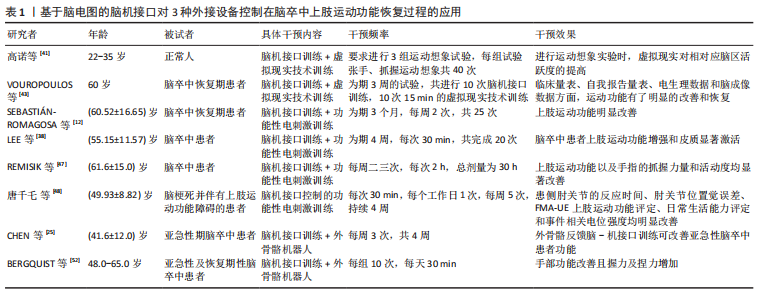Chinese Journal of Tissue Engineering Research ›› 2024, Vol. 28 ›› Issue (4): 581-586.doi: 10.12307/2023.865
Previous Articles Next Articles
Application of brain-computer interface technology based on electroencephalogram in upper limb motor function rehabilitation of stroke patients
Zhang Ming1, 2, 3, Wang Bin2, Jia Fan2, Chen Jie3, Tang Wei1
- 1School of Mechatronic Engineering, China University of Mining and Technology, Xuzhou 221116, Jiangsu Province, China; 2Department of Rehabilitation, Affiliated Xuzhou Rehabilitation Hospital of Xuzhou Medical University, Xuzhou 221003, Jiangsu Province, China; 3Department of Rehabilitation Medicine, Xuzhou Central Hospital, Xuzhou 221009, Jiangsu Province, China
-
Received:2022-11-22Accepted:2023-01-04Online:2024-02-08Published:2023-07-14 -
Contact:Tang Wei, Professor, Doctoral supervisor, School of Mechatronic Engineering, China University of Mining and Technology, Xuzhou 221116, Jiangsu Province, China -
About author:Zhang Ming, PhD candidate, School of Mechatronic Engineering, China University of Mining and Technology, Xuzhou 221116, Jiangsu Province, China; Department of Rehabilitation, Affiliated Xuzhou Rehabilitation Hospital of Xuzhou Medical University, Xuzhou 221003, Jiangsu Province, China; Department of Rehabilitation Medicine, Xuzhou Central Hospital, Xuzhou 221009, Jiangsu Province, China -
Supported by:National Natural Science Foundation of China (General Program), No. 51875566 (to TW); Jiangsu Province High-Level Health Personnel “Six-One Project” Top Talent Project, No. LGY2020030 (to ZM); Xuzhou Key Medical Talents Project, No. XWRCHT20220045 (to ZM); Major Research and Development Projects of Xuzhou Science and Technology Bureau, No. KC20133 (to ZM)
CLC Number:
Cite this article
Zhang Ming, Wang Bin, Jia Fan, Chen Jie, Tang Wei. Application of brain-computer interface technology based on electroencephalogram in upper limb motor function rehabilitation of stroke patients[J]. Chinese Journal of Tissue Engineering Research, 2024, 28(4): 581-586.
share this article
Add to citation manager EndNote|Reference Manager|ProCite|BibTeX|RefWorks

2.1 脑机接口技术的定义和分类 脑机接口技术是一项新兴技术,这项技术允许用户通过中枢神经系统解码患者的意图来控制外接设备,从而将大脑活动直接转化为运动动作[15]。为了获取大脑活动信号,可以通过侵入式和非侵入式两种信号采集策略[16]。侵入性信号采集可以获取时空信号,并具有通过植入大脑皮质来区分患者多维度意图的巨大能力[17]。然而由于安全和伦理问题,使用基于脑电图、脑磁图、功能近红外光谱或功能磁共振成像等收集大脑信号的非侵入性脑机接口技术,在实际应用中可能比侵入性脑机接口技术更有前途[18]。其中,基于脑电信号的脑机接口是较为常用的技术之一,因为它的设备要求相对简单和便宜,并且安全、无创、利于患者接受,同时可以捕捉到大脑活动的快速变化,并且可以在大多数环境下工作,它要求患者佩戴带有多个电极的帽子,该电极帽在应用时需要通过导电凝胶来降低电极和皮肤之间的阻抗,并且在每次治疗时均要重新定位以保证治疗效果,目前为了简化设置以及避免连接线移动造成的信号伪影,无线脑电系统变得越来越重要[19]。 基于脑电图的脑机接口技术可以采集并使用患者的神经信号作为输入信号,并提供实时反馈使患者能够直观地了解他们的大脑活动,同时可以在康复训练过程中控制计算机或机器人等外部设备,而不需要依赖残余肌肉控制[20-21]。在临床应用中,此类技术根据治疗作用的不同分为辅助性脑机接口和康复性脑机接口。通过特殊设备采集患者特征信号并将其转换为计算机可以识别的信号指令,同时通过外接控制设备以实现对患者肢体的有效精确控制,辅助患者能够完成日常生活和工作活动,称为辅助性脑机接口技术;另外一种是将脑机接口采集的患者脑电信号在康复训练过程中反馈给患者,诱导加强患者的大脑神经可塑性来帮助脑卒中患者恢复活动能力,提高其肢体的运动能力,称为康复性脑机接口[22]。基于脑电图的脑机接口技术流程示意图,见图3。"


2.2 不同模式脑电图脑机接口技术在脑卒中患者上肢康复中的应用 基于脑电图的脑机接口技术被认为是促进脑卒中后上肢运动功能恢复的潜在工具[23-24]。有随机对照研究表明,脑卒中患者可以通过脑机接口系统学习调节他们的脑电感觉运动节律来控制外部设备,这种康复训练模式可能会促进亚急性和慢性期脑卒中患者的神经恢复[10,25]。 根据大脑信号产生的模式,一般分为基于运动想象的脑电信号形式和基于运动尝试的脑电信号形式,两种形式的脑电信号都可以被识别,进而用来触发和驱动脑机接口外接设备如功能性电刺激或者外骨骼机器人,形成一个完整的闭环脑机接口系统。 运动想象可以被定义为对动作的排练,没有任何外在身体动作的心理活动,是一种复杂的认知操作,由患者自己产生[26]。在脑卒中患者首次进行上肢脑机接口训练的过程中,首先使患者进行运动想象,从而收集脑电数据并进行实时分析,通过这种方式,可以选择特定于患者的节奏并将其映射到外接设备进行控制动作。在正式训练过程中,脑机接口系统和通过脑机接口外接设备的耦合被认为是通过连接运动意念,被动控制患侧上肢提供适当的体感反馈来增强感觉运动的整合,从而通过对大脑活动的反馈来引导依赖活动的皮质可塑性[27]。MATTIA等[11]在对48例亚急性脑卒中患者进行基于运动想象的脑电信号形式的脑机接口训练中,采用每周3次共6周的康复方案,结果发现实验组患者受益于此种康复方案,并且训练效果能够长期保持,同时他们认为这种临床效果的改善可能是基于脑机接口的干预措施所利用的长期神经可塑性变化所维持。 除了运动想象,运动尝试即患者尽最大努力移动他们偏瘫的手,即使他们已经完全失去了自主运动,该模式也已经被用于脑卒中后脑机接口技术[28-29]。YOUNG等[30]认为采用运动尝试的脑电信号,目的是使神经反馈任务的训练条件尽可能类似于尝试真实世界上肢运动时所调用的心理过程,当使用脑机接口系统作为康复治疗的辅助反馈装置以帮助功能重建时,而不是作为替代丧失的功能的增强手段,重要的是受试者能够在实验室环境之外获得培训的效果。OSUAGWU等[31]在一项对四肢瘫痪患者进行的脑机接口训练研究中,采用运动尝试的脑电信号,外接设备采用功能性电刺激,结果发现实验组受试者体感诱发电位恢复,双侧腕关节活动度增大以及双手肌力明显改善。 有研究人员认为运动尝试比运动想象更有信息量,因为患者在运动想象时必须主动抑制肢体运动,而运动尝试时患者表现的更自然[32]。而在此次检索的文献中也未检索到基于以上两种脑电信号形式的脑机接口技术训练效果的比较,因此两者之间训练效果是否有差别尚无明确结论,需要进行多中心大样本的随机对照研究,以进一步判断以上两种脑机接口训练的影响。同时在临床实际应用时,不同患者对运动想象或者运动尝试训练方法的理解差异也应受到研究者的充分重视。 2.3 基于脑电图的脑机接口技术对外接设备的控制 脑机接口是一个记录和解码大脑信号的系统,并最终将脑机接口系统获取的与运动过程相关的神经生理信号实时翻译成计算机可以识别的指令,并利用这些信号控制外接设备,在大脑和肢体运动之间建立新的反馈联系,而无需外周神经和肌肉参与[2]。尽管具有不同反馈类型的脑机接口外接设备如虚拟现实技术[33-36]、功能性电刺激[37-38]、外骨骼机器人等设备在脑卒中患者的上肢功能康复方面已经显示出巨大的潜力[39-40],但其疗效观察仍然是目前研究的热点。 2.3.1 基于脑电图的脑机接口-虚拟现实系统与上肢运动功能恢复 虚拟现实技术通过提供丰富的反馈环境来提高患者的参与度和积极性,为个人提供身临其境的虚拟现实刺激环境,让个人能够更投入到虚拟环境中且沉浸式体验感更强,通过虚拟现实技术患者可以更好地控制脑机接口系统,提升脑机接口康复训练效果[41]。基于脑电图的脑机接口-虚拟现实系统的工作流程如下:首先是脑机接口系统通过特殊设备采集脑电信号,随即翻译转换成控制信号输出到虚拟现实系统,进行虚拟现实游戏场景和角色控制,相应地虚拟现实场景中的听觉、视觉以及触觉会对患者进行一系列的反馈,可以显著激活或抑制大脑的特定神经区域如感觉运动区和联合皮质区等,从而强化诱导受损大脑神经的修复重建,促进受损运动神经通路的恢复[42]。 VOURVOPOULOS等[43]观察了基于脑电图的脑机接口-虚拟现实系统在脑卒中后上肢康复应用的效果,该研究招募了1例60岁脑卒中恢复期的男性患者,患者接受为期3周的脑机接口-虚拟现实系统干预,共10次训练课程,结果表明在临床功能评分、自我报告评分、电生理数据和脑成像数据方面,患者上肢运动功能明显改善。这些结果表明,基于脑电图的脑机接口-虚拟现实系统对于上肢运动功能减退的脑卒中恢复期患者可能是有用的。但是由于该项研究是一个案例研究,这样的结果应该谨慎解读,需要进行更多的研究去验证这一结果的正确性。KHAN等[44]在用于脑卒中后康复的混合型脑机接口和虚拟现实系统设计一文中,研究了基于运动观察和运动想象脑机接口与虚拟现实系统对上肢运动控制水平低的患者的实用性和有效性,首先从患者的大脑活动中获取指示身体运动尝试的运动想象信号,并在分析之前对其进行预处理,随后将处理的运动想象信号去驱动虚拟现实场景中的上肢进行运动。该系统通过虚拟现实技术建立3D任务模型,该虚拟环境以患者的第一视角来呈现,通过视觉刺激以实现身临其境和引人入胜的用户体验。该系统的出现逐渐使传统的虚拟现实技术和现代脑机接口技术融合,更好地服务于脑卒中患者以及各种神经系统疾病患者。 基于脑电图的脑机接口-虚拟现实系统在康复医学的发展和应用中变得越来越重要,然而在使用该系统进行脑卒中后上肢运动功能康复过程中仍然存在一些挑战,例如脑机接口系统采集的脑电信号很弱,并且容易受到其他环境的干扰,如运动、肌电和眼电的干扰[33],尤其是当患者在虚拟现实环境中进行动作时,运动想象脑电信号会受到肢体运动所引发的脑电信号的极大干扰,因此后续的研究设计中可以选择能精准感知患者运动想象且便携轻巧适宜患者即时高沉浸的虚拟现实康复系统[45]。 2.3.2 基于脑电图的脑机接口-功能性电刺激系统与上肢运动功能恢复 功能性电刺激可使瘫痪的肌肉运动神经产生动作电位,进而使瘫痪的肢体产生功能性运动,并促进参与运动神经控制环路的体感皮质的激活,以达到改善脑卒中后患者运动功能的训练目的[46]。基于脑电图的脑机接口-功能性电刺激系统不仅通过促进肢体远端肌肉刺激的躯体感觉反馈,而且能够正确识别患者的运动意图,并发出指令控制功能性电刺激仪器完成预定的刺激,最终恢复肢体的运动功能和手部的抓握功能[12,36-37]。 REMSIK等[47]在一项脑机接口干预对脑卒中患者上肢运动功能康复的随机对照试验中,要求患者进行运动尝试的实际手部运动,包括手指伸展和屈曲,从而通过脑机接口信号采集设备采集患者的脑电信号进行功能性电刺激;当患者正确完成运动动作并与脑电信号匹配时,功能性电刺激设备被打开进行肌肉刺激,如果患者未匹配到正确的脑电信号,外部促进的肌肉功能性电刺激将永远不会发生。该研究还发现,有持续性上肢运动障碍的脑卒中患者在基于脑电的脑机接口-功能性电刺激闭环系统训练之后,患者的上肢运动功能以及手指的抓握力量和活动度均显著改善。国内学者唐千乇等[48]对比了基于运动想象的脑机接口-功能性电刺激系统和单纯的功能性电刺激对脑梗死后上肢运动功能障碍患者的康复治疗效果,对照组仅进行功能性电刺激,实验组进行脑机接口控制的功能性电刺激,两组功能性电刺激的参数调节都以出现目标动作为标准。在为期4周的训练后,两组患者的Fugl-Meyer评定量表上肢部分、改良Barthel指数、肘关节反应时间和肘关节位置觉误差均有改善,且实验组均优于对照组。该研究还进行了事件相关去同步化测试,以探究基于运动想象的脑机接口控制的功能性电刺激对脑卒中后患者的上肢运动功能改善的脑部神经改变机制。但是该研究中选择的受试者是3个月内的脑梗死患者,因此对于这个训练后康复效果的结论以及脑部神经改变机制的探究可能包含脑卒中后自发性神经修复的影响。李明芬等[49]研究发现,利用脑机接口电刺激技术治疗后脑卒中患者的上肢功能恢复显著,其治疗机制可能与促进患侧运动相关脑区激活有关,并促进脑卒中患者的中枢神经重塑。 基于脑电图的脑机接口介导的功能性电刺激被认为能显著改善脑卒中后上肢运动功能的恢复[50-51]。脑机接口-功能性电刺激康复训练形成了不同于以往的外周向中枢的训练机制,而是一种全新的自中枢向外周的主动训练模式。功能性电刺激的使用有助于增加单独使用脑机接口技术的临床效果,它不仅可以通过电刺激促进躯体感觉恢复,而且能够和大脑信号相匹配,从而促进远端肌肉出现功能性活动[52]。 2.3.3 基于脑电图的脑机接口-外骨骼机器人与上肢运动功能恢复 除了虚拟现实技术和功能性电刺激,脑机接口还可以和外骨骼机器人组成一套闭环训练系统,对上肢功能严重障碍的脑卒中患者进行辅助性康复训练[25,53-55]。针对上肢功能完全缺失的脑卒中患者,外骨骼机器人一方面可以按照设定程序执行某些特定动作完成患者丧失的活动,另一方面由脑机接口介导的外骨骼机器人可以通过脑电图反馈引导患者瘫痪的肢体去执行其所期望的活动,同时这些活动也可以反馈刺激受损的神经网络促进中枢相应功能区的连接[16]。此外,脑机接口-外骨骼机器人系统还可以允许患者根据自身意愿主动控制上肢进行移动,而不是被动设置的动作,这可以明显提高患者主动参与训练的积极性并显著提高康复效果[56-57]。 CHEN等[25]对14例亚急性期脑卒中患者上肢功能的研究中,脑机接口组每周进行3次由脑机接口介导的外骨骼机器人训练,共持续4周,对照组只进行常规康复治疗;当脑机接口系统正确识别患者运动尝试的脑电信号时,系统输出指令控制外骨骼设备驱动患侧手去完成手腕伸展运动,研究结果显示脑机接口组患者上肢运动功能恢复优于对照组。FROLOV等[54]将脑机接口结合外骨骼设备辅助物理治疗发现,其可以有效改善脑卒中后上肢运动障碍,对不同持续时间、严重程度和梗死位置的脑卒中患者都有一定的作用。LIN 等[58]通过运动想象-脑机接口系统控制外骨骼机械手,选择健康的年轻参与者16名接受了10次不同频率的非优势手功能训练,结果表明每天1次、持续5 d、每次30 min的训练时间可能是唤起皮质激活的最小有效剂量,这也为未来脑机接口技术在脑卒中上肢功能障碍的临床应用提供了重要的理论依据。 基于脑电图的脑机接口-外骨骼机器人系统针对脑卒中后手功能康复评分有着显著的改善,但大多数研究的机器人控制程度仅限于触发设备执行抓取或捏握的动作,并且这些脑机接口-外骨骼机器人系统也需要通过显示屏提供的视觉或听觉反馈相结合才能达到较好的训练效果[59]。目前也有新的研究采用双向脑机接口记录运动皮质的神经活动,通过对大脑皮质的微刺激产生触觉,将此触觉反馈到机械臂可以缩短瘫痪患者上肢抓取物体的时间[60]。 近年来,基于脑电图的脑机接口对3种外接设备控制在脑卒中上肢运动功能恢复过程的应用,见表1。"

| [1] BENJAMIN EJ, VIRANI SS, CALLAWAY CW, et al. Heart Disease and Stroke Statistics-2018 Update: A Report From the American Heart Association. Circulation. 2018;137(12):e67-e492. [2] COSCIA M, WESSEL MJ, CHAUDARY U, et al. Neurotechnology-aided interventions for upper limb motor rehabilitation in severe chronic stroke. Brain. 2019;142(8):2182-2197. [3] LACKLAND DT, ROCCELLA EJ, DEUTSCH AF, et al. Factors influencing the decline in stroke mortality: a statement from the American Heart Association/American Stroke Association. Stroke. 2014;45(1):315-353. [4] MADHOUN HY, TAN B, FENG Y, et al. Task-based mirror therapy enhances the upper limb motor function in subacute stroke patients: a randomized control trial. Eur J Phys Rehabil Med. 2020;56(3):265-271. [5] DEHEM S, GILLIAUX M, STOQUART G, et al. Effectiveness of upper-limb robotic-assisted therapy in the early rehabilitation phase after stroke: A single-blind, randomised, controlled trial. Ann Phys Rehabil Med. 2019; 62(5):313-320. [6] DERAKHSHANFAR M, RAJI P, BAGHERI H, et al. Sensory interventions on motor function, activities of daily living, and spasticity of the upper limb in people with stroke: A randomized clinical trial. J Hand Ther. 2021;34(4):515-520. [7] FRANCESCHINI M, MAZZOLENI S, GOFFREDO M,et al. Upper limb robot-assisted rehabilitation versus physical therapy on subacute stroke patients: A follow-up study. J Bodyw Mov Ther. 2020;24(1):194-198. [8] WARD NS, BRANDER F, KELLY K. Intensive upper limb neurorehabilitation in chronic stroke: outcomes from the Queen Square programme. J Neurol Neurosurg Psychiatry. 2019;90(5):498-506. [9] YANG SH, CHUNG EJ, LEE J, et al. The Effect of Trunk Stability Training Based on Visual Feedback on Trunk Stability, Balance, and Upper Limb Function in Stroke Patients: A Randomized Control Trial. Healthcare (Basel). 2021;9(5):532. [10] BIASIUCCI A, LEEB R, ITURRATE I, et al. Brain-actuated functional electrical stimulation elicits lasting arm motor recovery after stroke. Nat Commun. 2018;9(1):2421. [11] MATTIA D, PICHIORRI F, COLAMARINO E, et al. The Promotoer, a brain-computer interface-assisted intervention to promote upper limb functional motor recovery after stroke: a study protocol for a randomized controlled trial to test early and long-term efficacy and to identify determinants of response. BMC Neurol. 2020;20(1):254. [12] SEBASTIÁN-ROMAGOSA M, CHO W, ORTNER R, et al. Brain Computer Interface Treatment for Motor Rehabilitation of Upper Extremity of Stroke Patients-A Feasibility Study. Front Neurosci. 2020;14:591435. [13] 吴琼,任诗媛,乐赞,等.脑机接口综合康复训练对亚急性期脑卒中疗效的静息态功能磁共振研究[J].中国康复理论与实践,2020,26(1):77-84. [14] ROSENFELD JV, WONG YT. Neurobionics and the brain-computer interface: current applications and future horizons. Med J Aust. 2017;206(8):363-368. [15] SEBASTIÁN-ROMAGOSA M, UDINA E, ORTNER R,et al. EEG Biomarkers Related With the Functional State of Stroke Patients. Front Neurosci. 2020; 14:582. [16] LÓPEZ-LARRAZ E, SARASOLA-SANZ A, IRASTORZA-LANDA N, et al. Brain-machine interfaces for rehabilitation in stroke: A review. NeuroRehabilitation. 2018;43(1):77-97. [17] MILLER KJ, SCHALK G, FETZ EE, et al. Cortical activity during motor execution, motor imagery, and imagery-based online feedback. Proc Natl Acad Sci U S A. 2010;107(9):4430-4435. [18] RAMSEY NF. Human brain function and brain-computer interfaces. Handb Clin Neurol. 2020;168:1-13. [19] ABIRI R, BORHANI S, SELLERS EW, et al. A comprehensive review of EEG-based brain-computer interface paradigms. J Neural Eng. 2019;16(1): 011001. [20] MOHANTY R, SINHA AM, REMSIK AB, et al. Early Findings on Functional Connectivity Correlates of Behavioral Outcomes of Brain-Computer Interface Stroke Rehabilitation Using Machine Learning. Front Neurosci. 2018;12:624. [21] MENG J, ZHANG S, BEKYO A, et al. Author Correction: Noninvasive Electroencephalogram Based Control of a Robotic Arm for Reach and Grasp Tasks. Sci Rep. 2020;10(1):6627. [22] 陈树耿,贾杰.脑机接口在脑卒中手功能康复中的应用进展[J].中国康复理论与实践,2017,23(1):23-26. [23] PICHIORRI F, MATTIA D. Brain-computer interfaces in neurologic rehabilitation practice. Handb Clin Neurol. 2020;168:101-116. [24] CARVALHO R, DIAS N, CERQUEIRA JJ. Brain-machine interface of upper limb recovery in stroke patients rehabilitation: A systematic review. Physiother Res Int. 2019;24(2):e1764. [25] CHEN S, CAO L, SHU X, et al. Longitudinal Electroencephalography Analysis in Subacute Stroke Patients During Intervention of Brain-Computer Interface With Exoskeleton Feedback. Front Neurosci. 2020;14:809. [26] DICKSTEIN R, DEUTSCH JE. Motor imagery in physical therapist practice. Phys Ther. 2007;87(7):942-953. [27] PADFIELD N, ZABALZA J, ZHAO H,et al. EEG-Based Brain-Computer Interfaces Using Motor-Imagery: Techniques and Challenges. Sensors (Basel). 2019; 19(6):1432. [28] MURALIDHARAN A, CHAE J, TAYLOR DM. Extracting Attempted Hand Movements from EEGs in People with Complete Hand Paralysis Following Stroke. Front Neurosci. 2011;5:39. [29] DALY JJ, CHENG R, ROGERS J, et al. Feasibility of a new application of noninvasive Brain Computer Interface (BCI): a case study of training for recovery of volitional motor control after stroke. J Neurol Phys Ther. 2009; 33(4):203-211. [30] YOUNG BM, NIGOGOSYAN Z, REMSIK A, et al. Changes in functional connectivity correlate with behavioral gains in stroke patients after therapy using a brain-computer interface device. Front Neuroeng. 2014;7:25. [31] OSUAGWU BC, WALLACE L, FRASER M, et al. Rehabilitation of hand in subacute tetraplegic patients based on brain computer interface and functional electrical stimulation: a randomised pilot study. J Neural Eng. 2016;13(6):065002. [32] BLOKLAND Y, VLEK R, KARAMAN B, et al. Detection of event-related desynchronization during attempted and imagined movements in tetraplegics for brain switch control. Annu Int Conf IEEE Eng Med Biol Soc. 2012;2012:3967-3969. [33] WEN D, FAN Y, HSU SH, et al. Combining brain-computer interface and virtual reality for rehabilitation in neurological diseases: A narrative review. Ann Phys Rehabil Med. 2021;64(1):101404. [34] VOURVOPOULOS A, PARDO OM, LEFEBVRE S, et al. Effects of a Brain-Computer Interface With Virtual Reality (VR) Neurofeedback: A Pilot Study in Chronic Stroke Patients. Front Hum Neurosci. 2019;13:210. [35] MARIN-PARDO O, LAINE CM, RENNIE M, et al. A Virtual Reality Muscle-Computer Interface for Neurorehabilitation in Chronic Stroke: A Pilot Study. Sensors (Basel). 2020;20(13):3754. [36] COOGAN CG, HE B. Brain-computer interface control in a virtual reality environment and applications for the internet of things. IEEE Access. 2018;6:10840-10849. [37] BOUTON CE. Merging brain-computer interface and functional electrical stimulation technologies for movement restoration. Handb Clin Neurol. 2020;168: 303-309. [38] LEE SH, KIM SS, LEE BH. Action observation training and brain-computer interface controlled functional electrical stimulation enhance upper extremity performance and cortical activation in patients with stroke: a randomized controlled trial. Physiother Theory Pract. 2022;38(9):1126-1134. [39] LAU CCY, YUAN K, WONG PCM, et al. Modulation of Functional Connectivity and Low-Frequency Fluctuations After Brain-Computer Interface-Guided Robot Hand Training in Chronic Stroke: A 6-Month Follow-Up Study. Front Hum Neurosci. 2020;14:611064. [40] CHOWDHURY A, MEENA YK, RAZA H, et al. Active Physical Practice Followed by Mental Practice Using BCI-Driven Hand Exoskeleton: A Pilot Trial for Clinical Effectiveness and Usability. IEEE J Biomed Health Inform. 2018;22(6):1786-1795. [41] 高诺,陈鹏程.基于脑机接口与虚拟现实技术的手部软康复系统研究[J].生物医学工程研究,2022,41(1):32-40. [42] 何峰,何蓓蓓,王仲朋,等.脑-机交互运动训练的神经反馈方法及康复应用[J].中国生物医学工程学报,2021,40(6):719-730. [43] VOURVOPOULOS A, JORGE C, ABREU R, et al. Efficacy and Brain Imaging Correlates of an Immersive Motor Imagery BCI-Driven VR System for Upper Limb Motor Rehabilitation: A Clinical Case Report. Front Hum Neurosci. 2019;13:244. [44] KHAN MA, DAS R, IVERSEN HK, et al. Review on motor imagery based BCI systems for upper limb post-stroke neurorehabilitation: From designing to application. Comput Biol Med. 2020;123:103843. [45] 胡景钊,刘阳,贾巧妹,等.基于镜像神经元理论的便携式MI-VR BCI康复系统设计[J].西北大学学报(自然科学版),2021,51(4):567-576. [46] SOUSA ASP, MOREIRA J, SILVA C, et al. Usability of Functional Electrical Stimulation in Upper Limb Rehabilitation in Post-Stroke Patients: A Narrative Review. Sensors (Basel). 2022;22(4):1409. [47] REMSIK AB, DODD K, WILLIAMS L JR, et al. Behavioral Outcomes Following Brain-Computer Interface Intervention for Upper Extremity Rehabilitation in Stroke: A Randomized Controlled Trial. Front Neurosci. 2018;12:752. [48] 唐千乇,张通. 脑机接口控制的功能性电刺激对脑卒中患者上肢功能障碍的康复效果[J].中国康复理论与实践,2021,27(7):802-806. [49] 李明芬,贾杰,吴毅,等.基于脑机接口电刺激在脑卒中患者上肢康复中的应用研究[J].中华物理医学与康复杂志,2016,38(6):409-413. [50] BAI Z, FONG KNK, ZHANG JJ, et al. Immediate and long-term effects of BCI-based rehabilitation of the upper extremity after stroke: a systematic review and meta-analysis. J Neuroeng Rehabil. 2020;17(1):57. [51] SIMON C, BOLTON DAE, KENNEDY NC, et al. Challenges and Opportunities for the Future of Brain-Computer Interface in Neurorehabilitation. Front Neurosci. 2021;15:699428. [52] BERGQUIST AJ, CLAIR JM, LAGERQUIST O, et al. Neuromuscular electrical stimulation: implications of the electrically evoked sensory volley. Eur J Appl Physiol. 2011;111(10):2409-2426. [53] CANTILLO-NEGRETE J, CARINO-ESCOBAR RI, CARRILLO-MORA P, et al. Brain-Computer Interface Coupled to a Robotic Hand Orthosis for Stroke Patients’ Neurorehabilitation: A Crossover Feasibility Study. Front Hum Neurosci. 2021;15: 656975. [54] FROLOV AA, MOKIENKO O, LYUKMANOV R, et al. Post-stroke Rehabilitation Training with a Motor-Imagery-Based Brain-Computer Interface (BCI)-Controlled Hand Exoskeleton: A Randomized Controlled Multicenter Trial. Front Neurosci. 2017;11: 400. [55] BUNDY DT, SOUDERS L, BARANYAI K, et al. Contralesional Brain-Computer Interface Control of a Powered Exoskeleton for Motor Recovery in Chronic Stroke Survivors. Stroke. 2017;48(7):1908-1915. [56] VENKATAKRISHNAN A, FRANCISCO GE, CONTRERAS-Vidal JL. Applications of Brain-Machine Interface Systems in Stroke Recovery and Rehabilitation. Curr Phys Med Rehabil Rep. 2014;2(2):93-105. [57] LYUKMANOV RK, AZIATSKAYA GA, MOKIENKO OA, et al. Post-stroke rehabilitation training with a brain-computer interface: a clinical and neuropsychological study. Zh Nevrol Psikhiatr Im S S Korsakova. 2018; 118(8):43-51. [58] LIN Q, ZHANG Y, ZHANG Y, et al. The Frequency Effect of the Motor Imagery Brain Computer Interface Training on Cortical Response in Healthy Subjects: A Randomized Clinical Trial of Functional Near-Infrared Spectroscopy Study. Front Neurosci. 2022;16:810553. [59] BANIQUED PDE, STANYER EC, AWAIS M, et al. Brain-computer interface robotics for hand rehabilitation after stroke: a systematic review. J Neuroeng Rehabil. 2021;18(1):15. [60] FLESHER SN, DOWNEY JE, WEISS JM, et al. A brain-computer interface that evokes tactile sensations improves robotic arm control. Science. 2021; 6544(372):831-836. [61] 吴朝晖.脑机接口的未来发展趋势[J].智能系统学报,2022,17(1): 前插1. [62] 郝峻巍,刘海杰.基于人工智能的脑卒中超早期功能重建单元新模式[J].中华医学杂志,2022,102(4):302-306. [63] 王高峰,张志领.脑机接口隐私风险治理[J].科技管理研究,2022,42(5):204-209. [64] DREW L. The brain-reading devices helping paralysed people to move, talk and touch. Nature. 2022;604(7906):416-419. |
| [1] | Zhang Kefan, Shi Hui. Research status and application prospect of cytokine therapy for osteoarthritis [J]. Chinese Journal of Tissue Engineering Research, 2024, 28(6): 961-967. |
| [2] | He Yuanjie, Chen Yuheng, Zhao Yongchao, Wang Zhenglong. Progress in epigenetic regulation of vascular smooth muscle cell remodeling in the occurrence and development of aortic aneurysms [J]. Chinese Journal of Tissue Engineering Research, 2024, 28(4): 602-608. |
| [3] | Ma Sicong, Chen Jing, Li Yunqing. Functions and roles of connective tissue growth factor in nervous systems [J]. Chinese Journal of Tissue Engineering Research, 2024, 28(4): 615-620. |
| [4] | Yan Binghan, Li Zhichao, Su Hui, Xue Haipeng, Xu Zhanwang, Tan Guoqing. Mechanisms of traditional Chinese medicine monomers in the treatment of osteoarthritis by targeting autophagy [J]. Chinese Journal of Tissue Engineering Research, 2024, 28(4): 627-632. |
| [5] | Wang Xinyi, Xie Xianrui, Chen Yujie, Wang Xiaoyu, Xu Xiaoqing, Shen Yihong, Mo Xiumei. Electrospun nanofiber scaffolds for soft and hard tissue regeneration [J]. Chinese Journal of Tissue Engineering Research, 2024, 28(3): 426-432. |
| [6] | Long Jundong, Shi Yehong, Wang Cheng, Chen Shijiu. Effects of different freezing techniques on the rejection of allogeneic vascular transplantation [J]. Chinese Journal of Tissue Engineering Research, 2024, 28(3): 433-438. |
| [7] | Yang Jie, Hu Haolei, Li Shuo, Yue Wei, Xu Tao, Li Yi. Application of bio-inks for 3D printing in tissue repair and regenerative medicine [J]. Chinese Journal of Tissue Engineering Research, 2024, 28(3): 445-451. |
| [8] | Dai Xinyu, Yan Jihong, Hua Lingjun, Zheng Xiaohong. Resistance exercise improves body composition in overweight and obese people: an umbrella review [J]. Chinese Journal of Tissue Engineering Research, 2024, 28(2): 267-271. |
| [9] | Meng Zhicheng, Qiao Weiping, Zhao Yang, Liu Hongfei, Li Kaijie, Ma Bo. Effects of immune cells and related cytokines in the pathogenesis and treatment of osteoarthritis [J]. Chinese Journal of Tissue Engineering Research, 2024, 28(2): 280-287. |
| [10] | Long Yi, Yang Jiaming, Ye Hua, Zhong Yanbiao, Wang Maoyuan. Extracellular vesicles in sarcopenic obesity: roles and mechanisms [J]. Chinese Journal of Tissue Engineering Research, 2024, 28(2): 315-320. |
| [11] | Chang Wanpeng, Zhang Zhongwen, Yang Yulin, Zi Yang, Yang Mengqi, Du Bingyu, Wang Nan, Yu Shaohong. Efficacy of rehabilitation exoskeleton robots on post-stroke lower limb motor dysfunction: a Meta-analysis [J]. Chinese Journal of Tissue Engineering Research, 2024, 28(2): 321-328. |
| [12] | Ying Chunmiao, Pan Xiaolong, Liu Feixiang, Chen Na, Fan Feiyan, Zhang Yunke. Effect of traditional Chinese medicine and compounds for supplementing qi and activating blood circulation and inducing resuscitation on regulating stem cells to promote nerve repair of acute ischemic stroke [J]. Chinese Journal of Tissue Engineering Research, 2024, 28(1): 121-130. |
| [13] | Yang Ting, Ding Zhibin, Jiang Nan, Han Hongxia, Hou Miaomiao, Ma Cungen, Song Lijuan, Li Xinyi. Astrocytes regulate glial scar formation in cerebral ischemic stroke [J]. Chinese Journal of Tissue Engineering Research, 2024, 28(1): 131-138. |
| [14] | Long Qingxi, Zhang Pingshu, Liu Qing, Ou Ya, Zhang Lili, Yuan Xiaodong. Single-cell RNA sequencing reveals the heterogeneity of astrocytes [J]. Chinese Journal of Tissue Engineering Research, 2024, 28(1): 139-146. |
| [15] | Nong Fuxiang, Jiang Zhixiong, Li Yinghao, Xu Wencong, Shi Zhilan, Luo Hui, Zhang Qinglang, Zhong Shuang, Tang Meiwen. Bone cement augmented proximal femoral nail antirotation for type A3.3 intertrochanteric femoral fracturalysis [J]. Chinese Journal of Tissue Engineering Research, 2023, 27(在线): 1-10. |
| Viewed | ||||||
|
Full text |
|
|||||
|
Abstract |
|
|||||